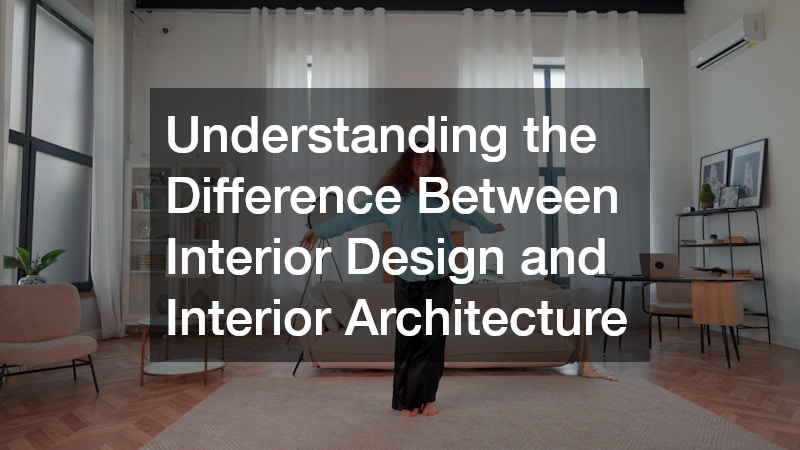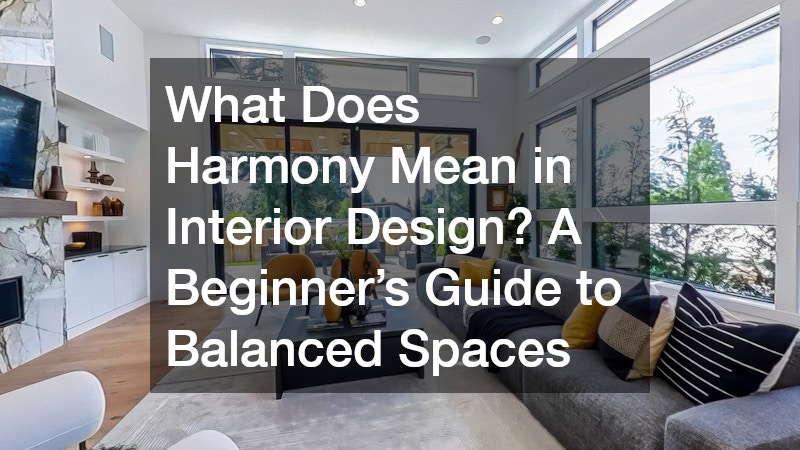
Whether you’re planning a home renovation, building a new house, or simply exploring the fascinating world of interior spaces, understanding the roles of interior design and interior architecture is crucial. These two disciplines often overlap, yet they serve distinct functions and require different expertise. For homeowners, knowing who to hire—and when—can save time, money, and headaches. For curious minds, the contrast between these fields opens up a deeper appreciation for the environments we live in.
In this article, we’ll break down the key differences between interior design and interior architecture in a clear, engaging way. You’ll learn what each professional does, how they’re trained, what kind of projects they handle, and which one might be best for your needs. Let’s dive in.
What Is Interior Design?
Interior design is the art and science of enhancing interior spaces to create aesthetically pleasing, functional, and safe environments. Interior designers focus primarily on the look, feel, and usability of indoor areas. From choosing color schemes to selecting furniture, lighting, and accessories, their job is to create harmonious, livable spaces tailored to the client’s lifestyle and preferences.
While some may think of interior design as simple decorating, professional interior designers undergo extensive training. They understand space planning, ergonomics, lighting design, sustainability, and even aspects of psychology. Their work is not only about beauty—it’s also about how people experience and move through a space.
Core Responsibilities of Interior Designers:
- Developing concepts based on client needs and preferences
- Selecting finishes, furniture, lighting, and decor
- Creating mood boards and design presentations
- Collaborating with contractors and suppliers
- Ensuring that designs meet safety codes and accessibility standards
- Enhancing space efficiency and flow
Interior designers often work in residential, commercial, hospitality, and retail environments. They can be involved from the early stages of a project, but typically they join once the structural layout is finalized.
What Is Interior Architecture?

Interior architecture involves the technical and structural planning of interior spaces. It’s a discipline that bridges architecture and interior design, focusing on how the interior of a building is constructed and arranged from a structural perspective. Interior architects often deal with building layouts, load-bearing walls, plumbing and electrical systems, and spatial functionality.
This field is especially important in renovation projects where altering the structure is required, such as moving walls, reconfiguring layouts, or upgrading HVAC systems. Interior architects ensure that the spaces are not only visually appealing but also safe, compliant, and functional at the core.
Core Responsibilities of Interior Architects:
- Structural planning and space layout
- Working with blueprints and CAD software
- Coordinating with architects and engineers
- Understanding building codes and regulations
- Designing customized built-ins and fixtures
- Planning lighting and utility systems from a structural perspective
Interior architects are usually trained as architects with a focus on interior environments. They are often licensed and must meet strict education and experience requirements.
What’s the Difference Between Interior Design and Interior Architecture?
Understanding the key differences between interior design and interior architecture is essential for choosing the right professional for your project. Although their work overlaps in many areas, their core focuses and skill sets are different.
Here’s a side-by-side comparison:
| Aspect | Interior Design | Interior Architecture |
| Focus | Aesthetic and functional layout, furnishings, finishes | Structural layout, spatial planning, and integration of building systems |
| Education | Design-focused; includes spatial planning and decor | Architecture-focused; includes engineering, safety, and structural systems |
| Licensing | May or may not require certification depending on the region | Often requires an architecture degree and licensure |
| Tools Used | Sketches, mood boards, software like SketchUp or Revit | Blueprints, CAD programs, building codes, and structural analysis |
| When to Hire | To enhance or style a space with no major structural changes | When altering structural layouts or ensuring code compliance |
| Examples of Work | Selecting paint colors, choosing furniture, and lighting design | Redesigning floor plans, removing/adding walls, and structural updates |
Who Should You Hire for Your Project?
Homeowners often ask, “Do I need an interior designer or an interior architect?” The answer depends on your project’s scope and goals. Here’s a quick guide to help you choose:
Hire an Interior Designer If:
- You want to redecorate or renovate without structural changes
- You need help choosing finishes, colors, or furnishings
- You’re updating kitchens or bathrooms cosmetically
- You want expert guidance on style and functionality
Hire an Interior Architect If:
- You’re remodeling or building a new home
- You plan to move walls or change layouts
- You need help with lighting, HVAC, or plumbing plans
- Your project must meet complex safety or building regulations
Many larger projects benefit from both professionals working together. For example, an interior architect might handle structural changes, while an interior designer brings the aesthetic vision to life.
How Are They Trained and Certified?
Training paths differ significantly between interior designers and interior architects. Understanding their qualifications can help you gauge their expertise.
Interior Designer Education:
- Bachelor’s or Associate degree in Interior Design
- Training in color theory, space planning, lighting, and furnishings
- May earn certification through bodies like NCIDQ (National Council for Interior Design Qualification)
- Ongoing professional development through design organizations
Interior Architect Education:
- Bachelor’s or Master’s degree in Architecture (often with a focus on interiors)
- Intensive training in construction, structural systems, and building codes
- Must complete licensure exams (such as the ARE in the U.S.)
- Registered with architectural boards or councils
Because of the technical demands of the role, interior architects often carry more legal responsibility, especially when dealing with compliance and building safety.
Can One Person Do Both?
It’s not uncommon to find professionals who blend the roles of interior designer and architect, especially in boutique design studios or multidisciplinary firms. However, not all interior designers are trained to handle structural elements, and not all architects have an eye for styling and décor.
If you’re working on a complex project, consider hiring a team or a firm that offers integrated design services—this ensures a seamless process from floor plan to furniture selection.
Why the Distinction Matters for Homeowners
For homeowners, hiring the right professional from the start can streamline your project and reduce unnecessary costs. Here’s why understanding the difference matters:
- Avoids scope creep – You won’t hire someone only to realize they can’t legally handle your structural remodel.
- Saves time and budget – The right expert can guide you efficiently through decisions, permits, and design options.
- Improves communication – Knowing what each role does helps you coordinate between professionals more effectively.
- Ensures legal compliance – Structural work often requires permits and certifications, which only licensed professionals can provide.
If you’re uncertain, start by outlining your needs. Are you changing layouts, or just revamping finishes? Answering that will clarify which expertise is essential.
Real-Life Example: Kitchen Renovation
To illustrate, let’s compare how each professional would approach the same project—a kitchen renovation.
Interior Designer’s Role:
- Help select cabinetry styles, countertop materials, and color palettes
- Optimize kitchen flow with the existing layout
- Choose light fixtures and hardware that match your style
- Recommend paint colors, backsplashes, and accessories
Interior Architect’s Role:
- Reconfigure the layout to improve traffic flow or add space
- Relocate plumbing or gas lines
- Ensure structural integrity when removing walls or opening space
- Prepare construction documents for permits and contractor use
For a simple style refresh, an interior designer is your go-to. For a full-scale rework of the space, you’ll want an interior architect involved.
The Evolution of Interior Spaces: How the Two Roles Developed Over Time

The fields of interior design and interior architecture didn’t always exist as separate disciplines. Historically, architecture encompassed both the structure and the interior aesthetics. However, as buildings and user needs became more complex, specialization emerged. By the 20th century, interior design gained recognition as a profession distinct from architecture, focusing more on human interaction, comfort, and style within a given space.
Interior architecture, on the other hand, evolved from the technical side of architecture. It arose to meet the growing demand for interior spaces that are not only beautiful but also structurally adaptive, especially in urban renovation projects where existing buildings must be repurposed. As sustainability and adaptive reuse become more important, interior architecture continues to bridge form and function. Today, both roles work in tandem more than ever, blending their strengths to shape environments that are both livable and lasting.
Technology’s Role in Interior Design and Architecture
Modern technology has significantly transformed how interior designers and interior architects work. Advanced software such as AutoCAD, Revit, SketchUp, and BIM (Building Information Modeling) allows professionals to create highly detailed 3D models, simulate lighting, and visualize materials before construction even begins. These tools enhance collaboration between disciplines and allow for more efficient decision-making.
Interior designers use virtual design tools to present mood boards, color palettes, and furniture layouts in photorealistic formats, giving clients a clearer vision of the final outcome. Meanwhile, interior architects rely on precise modeling to ensure their structural modifications comply with safety codes and engineering standards.
Additionally, smart home integration and sustainable technologies are now central considerations. Designers and architects must stay current with automation systems, energy-efficient materials, and green certifications. The result is a more streamlined, innovative process that produces spaces tailored not just to visual taste, but also to performance, comfort, and environmental responsibility.
Cost Considerations: Budgeting for Each Professional
Budget is often a deciding factor in choosing between an interior designer and an interior architect. While both professionals charge for their expertise, the cost structures and scopes of their work can differ significantly. Interior designers typically charge by the hour, per square foot, or as a flat fee based on the size and complexity of the project. Their rates may also vary depending on experience and geographic location.
Interior architects, due to their technical training and licensing, generally have higher fees. They may charge a percentage of the overall construction cost or operate under a structured contract similar to architectural firms. This is especially true when projects require permit drawings, structural changes, or engineering coordination.
In some cases, hiring both professionals is more cost-effective than hiring one person to wear both hats, especially if the project involves design and structural changes. Knowing your budget and project scope ahead of time will help you allocate resources wisely and avoid costly revisions later on.
Final Thoughts: Collaborate for the Best Results
Interior design and interior architecture are both vital to the spaces we inhabit. While one brings artistry and human-centered style, the other ensures that beauty rests on a solid, safe foundation. As a homeowner, understanding their distinctions allows you to communicate clearly, make informed decisions, and ultimately create a home that is both inspiring and structurally sound.
Whenever possible, bring both professionals into your project. Collaboration between interior designers and interior architects leads to the most creative, functional, and safe outcomes, exactly what every homeowner wants.




